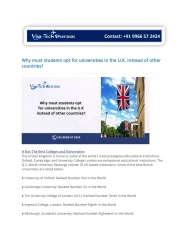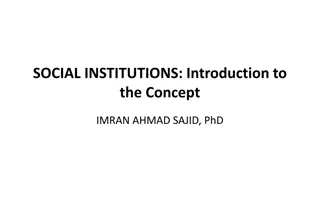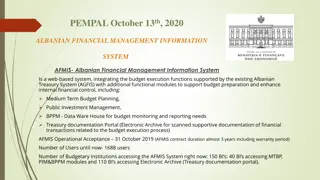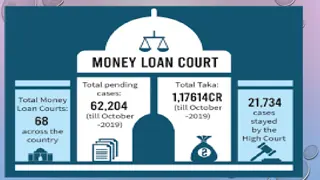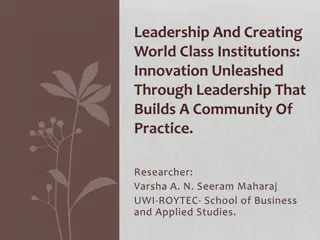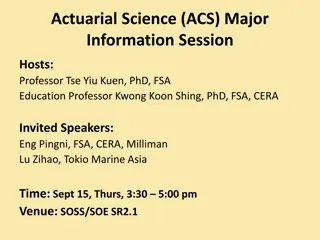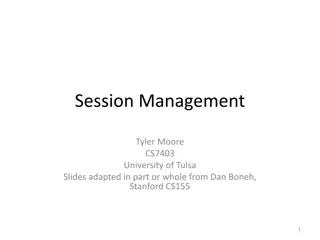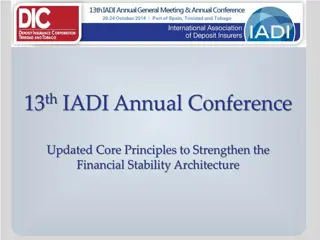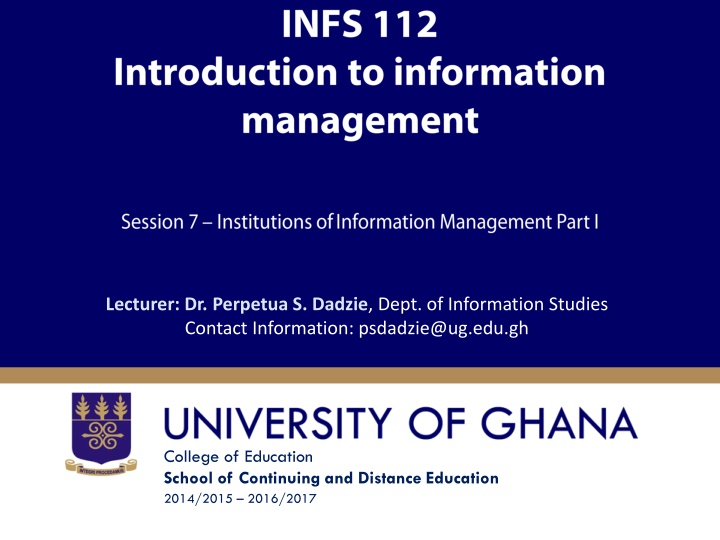
Libraries, Archives, and Museums in Information Studies
Explore the functions and importance of libraries, archives, and museums in the field of information studies. Learn about their roles in preserving knowledge and providing access to information resources. Discover key topics covered in sessions and reading lists related to these areas.
Uploaded on | 2 Views
Download Presentation

Please find below an Image/Link to download the presentation.
The content on the website is provided AS IS for your information and personal use only. It may not be sold, licensed, or shared on other websites without obtaining consent from the author. If you encounter any issues during the download, it is possible that the publisher has removed the file from their server.
You are allowed to download the files provided on this website for personal or commercial use, subject to the condition that they are used lawfully. All files are the property of their respective owners.
The content on the website is provided AS IS for your information and personal use only. It may not be sold, licensed, or shared on other websites without obtaining consent from the author.
E N D
Presentation Transcript
Lecturer: Dr. Perpetua S. Dadzie, Dept. of Information Studies Contact Information: psdadzie@ug.edu.gh College of Education School of Continuing and Distance Education 2014/2015 2016/2017
Session Overview At the end of the session, the student will be able to: Describe the functions of a library State the importance of Archives and Records Centers Understand the role of Museums Slide 2 Dr. Perpetua Dadzie, Dept of Information Studies
Session Outline The key topics to be covered in the session are as follows: Topic One - Libraries Topic Two Archives and Records centres Topic Three Museums Slide 3 Dr. Perpetua Dadzie, Dept of Information Studies
Reading List Museum https://en.wikipedia.org/wiki/Museum What are archives and records? http://www.proni.gov.uk/index/new_to_archives/what_are_a rchives_and_records.htm Slide 4 Dr. Perpetua Dadzie, Dept of Information Studies
Topic One LIBRARIES Slide 5 Dr. Perpetua Dadzie, Dept of Information Studies
What are Libraries? Traditionally, libraries regarded as collection of books used for reading or study, or building or room in which such a collection is kept. Today, libraries are collection of information resources in print or in other forms that are organized and made accessible for reading or study. Libraries house collections of books, manuscripts, journals, and other sources of recorded information. Slide 6 Dr. Perpetua Dadzie, Dept of Information Studies
What are Libraries? (2) Resources include reference works, such as encyclopaedias that provide factual information; indexes that help users find information in other sources; creative works, including poetry, novels, short stories, music scores, and photographs; nonfiction, such as biographies, histories, and other factual reports; periodical publications, including magazines, scholarly journals and books published as part of a series. Slide 7 Dr. Perpetua Dadzie, Dept of Information Studies
What are Libraries? (3) Libraries now also repositories and access points for maps; microform (microfilm/microfiche), audio tapes, CDs, cassettes, videotapes and DVDs; subscription databases, and the Internet. Thus, modern libraries are increasingly being redefined as places to get unrestricted access to information in many formats and from many sources. Libraries extend beyond the physical walls of a building, by including material accessible by electronic means. Slide 8 Dr. Perpetua Dadzie, Dept of Information Studies
What are Libraries? (4) Libraries also provide the services of specialists, librarians, who are experts at finding and organizing information and at interpreting information needs. Librarians navigate and analyze tremendous amounts of knowledge with a variety of digital tools. Increasingly librarians have assumed the role of educator to teach their users how to find information both in the library and over electronic networks. Public librarians have expanded their roles by providing local community information through publicly accessible computing systems. Slide 9 Dr. Perpetua Dadzie, Dept of Information Studies
What are Libraries? (5) Technology changed ways of creating, storing, organizing, and providing information. Libraries have sophisticated on-line catalogs that allow users to find out whether or not a book has been checked out and what other libraries have it. Libraries provide Selective Dissemination of Information (SDI) services - librarians choose information that may be of interest to their users and forward it to them before the users request it. Slide 10 Dr. Perpetua Dadzie, Dept of Information Studies
Types of Libraries Different types of libraries Purpose is to encourage the lifelong self -education to one and all. It should provide one and all with current information on all subjects. It should disseminate in an unbiased and balance way all shades of recorded views to one and all to enable them discharge their political responsibilities in respect of local, national and international affairs (Ranganathan 1962). Slide 11 Dr. Perpetua Dadzie, Dept of Information Studies
Types of Libraries (2) Academic Libraries located on campuses of colleges and universities and serve primarily students and faculty of that and other academic institutions. Some academic libraries, especially those at public institutions, are accessible to members of the general public in whole or in part. Public Libraries provide service to general public and make at least some of their books available for borrowing, so that readers may use them at home over a period of days or weeks. issue library cards to community members wishing to borrow books. serve as community organizations that provide free services and events to public, such as reading groups and toddler story time. Slide 12 Dr. Perpetua Dadzie, Dept of Information Studies
Types of Libraries (3) Research libraries for supporting scholarly research, and therefore maintain permanent collections and attempt to provide access to all necessary material. Research libraries are most often academic libraries or national libraries, but many large special libraries have research libraries within their special field and a very few of the largest public libraries also serve as research libraries. School libraries Most public and private primary and secondary schools have libraries designed to support the school's curriculum. Slide 13 Dr. Perpetua Dadzie, Dept of Information Studies
Types of Libraries (4) Special libraries All other libraries fall into this category. Many private businesses and public organizations, including hospitals, museums, research laboratories, law firms, and many government departments and agencies, maintain their own libraries for the use of their employees in doing specialized research related to their work. Special libraries may or may not be accessible to some identified part of the general public. Branches of a large academic or research libraries dealing with particular subjects are also usually called "special libraries": they are generally associated with one or more academic departments. Special libraries are distinguished from special collections, which are branches or parts of a library intended for rare books, manuscripts, and similar material. Slide 14 Dr. Perpetua Dadzie, Dept of Information Studies
Divisions of a Library Larger libraries often broken down into departments staffed by both paraprofessionals and professional librarians. Circulation handles user accounts and the loaning/returning and shelving of materials. Collection Development orders materials and maintains materials budgets. Reference staffs a reference desk answering user questions (using structured reference interviews), instructing users, and developing library programming. Reference may be further broken down by user groups or materials; common collections are children s literature, young adult literature, and genealogy materials. Technical Services works behind the scenes cataloguing and processing new materials and de accessioning weeded materials. Slide 15 Dr. Perpetua Dadzie, Dept of Information Studies
Topic Two ARCHIVES AND RECORDS CENTRES Slide 16 Dr. Perpetua Dadzie, Dept of Information Studies
What are Archives/Records centres? An archive -a collection of historical records, and the location in which the collection is kept. Archives contain records (primary source documents) which have accumulated over the course of an individual or organization's lifetime. A repository for an organized body of records produced or received by a public, semipublic, institutional, or business entity in the transaction of its affairs and preserved by it or its successors. archives consist of records which have been selected for permanent or long-term preservation, due to their enduring research value. Slide 17 Dr. Perpetua Dadzie, Dept of Information Studies
What are Archives/Records centres? (2) Archival records are normally unpublished and almost always unique, unlike books or magazines, in which many identical copies exist. This means that archives (the places) are quite distinct from libraries with regard to their functions and organization, although archival collections can often be found within library buildings. Archives of an individual may include letters, papers, photographs, computer files, scrapbooks, financial records or diaries created or collected by the individual regardless of media or format. Slide 18 Dr. Perpetua Dadzie, Dept of Information Studies
What are Archives/Records centres? (3) The archives of an organization (such as a corporation or government) tend to contain other types of records, such as administrative files, business records, memos, official correspondence and meeting minutes. A person who works in archives is called an archivist. Archivists collect, organize, and maintain control over a wide range of information deemed important enough for permanent safekeeping. This information takes many forms: photographs, films, video and sound recordings, and electronic data files in a wide variety of formats, as well as more traditional paper records, letters, and documents. Slide 19 Dr. Perpetua Dadzie, Dept of Information Studies
What are Archives/Records centres? (4) Archivists maintain records in accordance with accepted standards and practices that ensure long- term preservation and easy retrieval of documents. Records may be saved on any medium, including paper, film, videotape, audiotape, computer disk, or DVD. They also may be copied onto some other format to protect original and to make the records more accessible to researchers who use them. Slide 20 Dr. Perpetua Dadzie, Dept of Information Studies
What are Archives/Records centres? (5) Archivists often specialize in an area of history so they can more accurately determine which records in that area qualify for retention and should become part of the archives. Archivists also may work with specialized forms of records, such as manuscripts, electronic records, photographs, cartographic records, motion pictures, and sound recordings. Computers are increasingly being used to generate and maintain archival records. Professional standards for the use of computers in handling archival records are still evolving. Slide 21 Dr. Perpetua Dadzie, Dept of Information Studies
Types of Archives Five major types of archives - academic, for profit (business), government, non profit, and others. Academic Archives in colleges, universities, and other educational facilities are typically housed within a library, and duties may be carried out by an archivist or a librarian. Academic archives exist to preserve and celebrate the history of their school and academic community. An academic archive may contain items such as papers of former professors and presidents, memorabilia related to school organizations and activities, and items the academic library wishes to remain in a closed-stack setting, such as rare books or thesis copies. Slide 22 Dr. Perpetua Dadzie, Dept of Information Studies
Types of Archives (2) Business (for profit) Archives located in for-profit institutions are usually those owned by a private business. These corporate archives maintain historic documents and items related to the history of their companies. Business archives serve the purpose of helping their corporations maintain control over their brand by retaining memories of the company's past. Government Government archives include those run on a local and state level as well as those run by the national (or federal) government. Anyone may use a government archive, and frequent users include reporters, genealogists, writers, historians, students, and people wanting information on the history of their home or region. Many government archives are open to the public and no appointment is required to visit. Slide 23 Dr. Perpetua Dadzie, Dept of Information Studies
Types of Archives (3) Non-profit Non-profit archives include those in historical societies, not-for-profit businesses such as hospitals, and the repositories within foundations. Non-profit archives are typically set up with private funds from donors to preserve the papers and history of specific persons or places. Often these institutions rely on grant funding from the government as well. Slide 24 Dr. Perpetua Dadzie, Dept of Information Studies
Activities Visit any library of your choice and describe the staff that they have, the different departments and what they do there. Visit the National Archives in your country and find out what goes on there. Write a one page report of your experience there. Slide 25 Dr. Perpetua Dadzie, Dept of Information Studies
Topic Three MUSEUMS Slide 26 Dr. Perpetua Dadzie, Dept of Information Studies
What are Museums? Permanent institution in the service of society and of its development, open to the public, which acquires, conserves, researches, communicates and exhibits the tangible and intangible heritage of humanity and its environment, for the purposes of education, study, and enjoyment " (International Council of Museums) Museums enable people to explore collections for inspiration, learning and enjoyment. They are institutions that collect, safeguard and make accessible artifacts and specimens, which they hold in trust for society (UK Museums Association 1998 ). Slide 27 Dr. Perpetua Dadzie, Dept of Information Studies
What are Museums? (2) collect and care for objects of scientific, artistic, or historical importance and make them available for public viewing through exhibits that may be permanent or temporary. offer programs and activities for a range of audiences, including adults, children, and families, as well as those for more specific professions. Programs for the public may consist of lectures or tutorials by the museum faculty or field experts, films, musical or dance performances, and technology demonstrations. Many times, museums concentrate on the host region's culture. Slide 28 Dr. Perpetua Dadzie, Dept of Information Studies
What are Museums? (3) Although most museums do not allow physical contact with associated artifacts, there are some that are interactive and encourage a more hands-on approach. Modern trends in museology have broadened the range of subject matter and introduced many interactive exhibits, which give the public the opportunity to make choices and engage in activities that may vary the experience from person to person. With the advent of the Internet, there are growing numbers of virtual exhibits, , i.e. web versions of exhibits showing images and playing recorded sound. Slide 29 Dr. Perpetua Dadzie, Dept of Information Studies
What are Museums? (4) usually open to the general public, sometimes charging an admission fee. Some museums are publicly funded and have free entrance, either permanently or on special days, e.g. once per week or year. usually not run for the purpose of making a profit, unlike private galleries which more often engage in the sale of objects. There are governmental museums, non-governmental or non-profit museums, and privately owned or family museums. Museums can be a great source of information about cultures and history. normally houses a core collection of important selected objects in its field. Objects are formally accessioned by being registered in the museum's collection with an artifact number and details recorded about their provenance. persons in charge of the collection and of the exhibits are known as curators. Slide 30 Dr. Perpetua Dadzie, Dept of Information Studies
Functions of a Museum Museums serve to homogenize our views of the past by the following means: presenting the past in terms of a coherent, linear, unified narrative creating complex audio, visual and textual experiences, in which the observer is overwhelmingly confronted by the massive weight of all the physical evidence presenting a view of history based entirely upon the romanticization of the achievements of great men, brilliant thinkers, cultural or scientific innovators, war heroes (and their technologies) Slide 31 Dr. Perpetua Dadzie, Dept of Information Studies
Types of Museums Categories include: fine arts, applied arts, craft, archaeology, anthropology and ethnology, history, cultural history, military history, science, technology, children's museums, natural history, numismatics, botanical and zoological gardens and philately. Art museum, also known as an art gallery, is a space for the exhibition of art, usually in the form of art objects from the visual arts, primarily paintings, illustrations, and sculpture. Collections of drawings and old master prints are often not displayed on the walls, but kept in a print room. There may be collections of applied art, including ceramics, metalwork, furniture, artist's books and other types of object. Video Art is often screened. Slide 32 Dr. Perpetua Dadzie, Dept of Information Studies
Types of Museums (2) History museums cover the knowledge of history and its relevance to the present and future. Some cover specialized curatorial aspects of history or a particular locality; others are more general. Such museums contain a wide range of objects, including documents, artifacts of all kinds, art, archaeological objects. Antiquities museums specialize in more archaeological findings Science museums and technology centers revolve around scientific achievements, and marvels and their history. To explain complicated inventions, a combination of demonstrations, interactive programs and thought-provoking media are used. Some museums may have exhibits on topics such as computers, aviation, railway museums, physics, astronomy, and the animal kingdom. Slide 33 Dr. Perpetua Dadzie, Dept of Information Studies
Activity Visit any museum of your choice and describe what you see there. You can visit the Archaeological Museum at Legon or the National Museum in Accra . Slide 34 Dr. Perpetua Dadzie, Dept of Information Studies
Video Types of libraries and their functions <iframe width="420" height="315" src="https://www.youtube.com/embed/TMGVN75w qlQ" frameborder="0" allowfullscreen></iframe> Slide 35 Dr. Perpetua Dadzie, Dept of Information Studies
References Slide 36 Dr. Perpetua Dadzie, Dept of Information Studies



